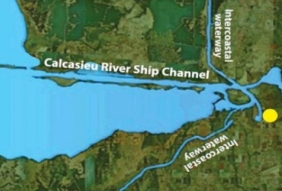
Posted on May 24, 2016
By Crystal Stevenson, AmericanPress.com
The Calcasieu Ship Channel drives Southwest Louisiana’s oil, gas and chemical industries. That means it drives Southwest Louisiana’s economy, said Port of Lake Charles Director Bill Rase.
“Our area has over $40 billion in projects under construction to date — I don’t think a lot of people recognize that — and there’s a lot more to come,” he said. “Every bit of this new growth depends upon the ship channel being here and at its authorized dimensions of 40 feet deep by 400 feet wide.”
Without the ship channel, Rase said, “none of this exists.”
Rase said 46 percent of the Lake Area metro economy depends on the health of the ship channel. By 2023, the projected economic expansion tied to the channel is forecast to increase channel-dependent local revenue by nearly 80 percent.
Lake Charles has the 11th-busiest U.S. port based on tonnage, Rase said, with about 1,000 deep-draft vessels traveling through the channel annually, carrying about 56.5 million tons of cargo.
If the channel isn’t maintained as it was designed, vessels needed for existing and new industries can’t come to the area.
Maintaining the channel at its authorized dimensions is critical to supporting the anticipated expansion, he said, and that requires regular dredging.
Rase said there are two parts to dredging: removing the material from the bottom of the channel and placing the material in disposal areas along the channel. The U.S. Army Corps of Engineers, as an arm of the federal government, is responsible for maintaining the channel. The Port of Lake Charles, which acts as the local sponsor of the channel on behalf of the state, must share in the expense of creating more disposal capacity.
“The actual dredging now requires a cost-share of 25 percent from the local sponsor,” Rase said. “We have to figure out a way to cover that 25 percent, and if we don’t, then we don’t get dredged.”
The last dredging cycle cost the port $3.3 million for its cost-share portion. Rase said mile five to mile 17 of the channel will be dredged in the next cycle, which will begin in August. The Corps has requested that the port pay $2.6 million, due this summer, for its share of the cost.
Rase said it costs $30 million-$40 million a year to maintain the channel at the federally authorized dimensions. He said the Corps of Engineers rarely receives enough money from the federal government, so work on the disposal areas has been neglected to be able to continue dredging. Now much of the cost to rebuild the disposal areas has been shifted to the port.
Acquiring new land for disposal sites and preparing it to receive dredge spoil is the other big cost factor, Rase said. The port is responsible for 100 percent of the cost of the real estate and 25 percent of the cost of building levees to contain the spoil.
Rase said that during his 10 years with the port, the cost of purchasing land for disposal areas has gone up tremendously due to increasing property values and wetland mitigation costs. The cost of buying disposal sites and preparing them is estimated to be $80 million over the next 20 years.
“If we don’t have sites to put the spoil into, we don’t get dredged. That’s the bottom line,” he said.
“The cost-share is there on both sides, but the biggest number comes from the confined disposal sites, which require you to build levees; you have to put in weirs; you have to drain the property. If you don’t do that, then you use up two to three times more land to put something down.
“You can see that exponentially, keeping the channel dredged is going to be a large issue for years,” he said. “It will cost more 20 years from now than what it costs today.”
To ensure the channel can meet the needs of business and industry, Rase said, the port is asking the state to provide the funding it promised years ago when the design and construction of the channel took place.
“It’s really got to become an appropriation by the state to take care of the channel,” he said. “Every year, it’s one or the other: real estate buying, channel dredging, dike improvements, installation of drainage.”
Rase said the state gets about $118 million in taxes from channel-related activity in Calcasieu Parish alone.
“We’re asking for about $8 million a year back to keep the channel open,” he said. “We’re just trying to get the state to recognize and live up to what its agreement with the Corps of Engineers is. What we need now is state support.”
Rase said the secretary of the state Department of Transportation and Development toured the channel two weeks ago and has recommended that Gov. John Bel Edwards visit, as well.
“We just can’t wait forever because the port can’t do both: We can’t take care of the channel and do all the other things we’re doing to operate the port and grow the economy, because we’d be bankrupt,” he said. “The $6 billion, $8 billion, $10 billion projects aren’t going to want to come to an area with a channel that’s not maintained.
“All these things are kind of like a crawfish hole. They’re starting to build up,” Rase said. “and if we don’t take care of them, of course, eventually it’ll fall over.”
Source: AmericanPress.com





